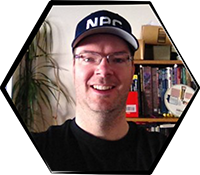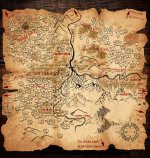Stephan Hornick
Community Goblin & Master of the Archive
Platinum WoA
Wizard of Story
Wizard of Combat
Borderland Explorer

Encounter Mapping Software - 3 Tips For Choosing The Best One
By JohnnFour | Published November 29, 2021
Roleplaying Tips Newsletter #1,182
A great conversation came up in the monthly Wizard of Adventure chat Saturday on what encounter mapping software to choose.
(Wizards of Adventure who could not make the call, here's a link to the recording.)
From DungeonFog to HexKit to Campaign Cartographer, and a bunch of others, how do you pick?
Because it's not just about spending your hard-earned gold pieces on an encounter mapping solution.
It's also about investing time into something you want to produce actual results for your campaigns.
In our busy lives, no one wants to waste themselves on red herrings.
The following is a simple framework I laid out in the call to help you narrow down your choices faster.
It's not a scientific framework.
But it's derived from a past life as a technical illustrator and graphics creator. And from personal experience playing with a lot of mapping tools over the years.
I hope you'll find this framework helpful when choosing your next encounter mapping software.
(Also, I've started adding reader tips to the newsletter now. Today I've got some great old school encounter challenge tips for you from RPT GM Gwydion. Scroll to the end to read.)
Three Types of Encounter Mapping Apps
I put mapping software into three buckets based on how a GM thinks and creates:
- Drawing
- Painting
- Scrapbooking
Let's explore each one to see how it might map to you, pun intended!
Bucket #1: Do You Like to Paint?
If you enjoy painting, then you understand "area control of a canvas."
You also understand that each stroke is permanent. A card laid is a card played.
If we think of maps as information, then as a painter you see your maps as zones, swathes of functions or features, and patches of information and effect.
While digital tools allow layers for easy separation and manipulation of information, your painter worldview doesn't rely on that to make sense of your info.
You also see canvas and brush more holistically and in terms of how things blend together and layer for effect.
You mix pigments, explore within the frame, and aim for an overall experience.
This is all generally speaking, as a metaphor for what kind of mapping software you might enjoy or grok most.
For, in this category, I put all "pixel painters."
In a pixel painter, like Photoshop, Gimp, Wonderdraft, and so on, you're using a digital brush to lay swathes of pixels onto a canvas.
You use brush styles and thickness, along with the eraser, to paint your encounter maps.
In general, this makes for fast map creation but less granular control.
You also can draw more abstract maps with fuzzy boundaries.
This approach supports gridless combats well too.
Now, Photoshop and similar apps are powerful, and they cross the three categories I'm laying out here for you today.
The main intent with this bucket is, when you encounter a map app for the first time, and you have a painter's mindset, look first to see if it lays down pixels via brushes and fills.
Bucket #2: Do You Like to Draw?
On the other end of the spectrum we have object-oriented mappers.
What I mean by that is, you grab an object like a room, cave, furnishing, or symbol of any kind, and drop it onto the canvas and manipulate it in isolation.
Unlike painting where your map is a whole and blended piece, drawing turns your map into a bunch of things or objects.
If you are familiar with CAD, Adobe Illustrator, Google Slides/PowerPoint, or other vector-based software, then you'll be comfortable with RPG mapping software that offers similar features.
The reason I liken this to hand-drawing is you become very concerned with edges.
In vector software you manipulate the size, shape, and position of map elements by selecting edges and using a tool, applying an effect, or dragging your mouse to change a specific aspect of the object.
This can overwhelm painters and scrapbookers who just want to compose a single wonderful piece in broad strokes, to continue the metaphor and puns.
I'm in the drawing camp though.
I love the specificity, level of control, and amount of detail I can put into encounter maps via objects because I have my own special approach to using maps to increase challenges, make encounters interesting, and build cool stories.
Well, I say it's my own special way — maybe you have the same methods and techniques — I just haven't found anything similar online or in books anywhere.
The downside to being a drawer is it takes longer to build maps.
You get picky about placing things.
It takes extra clicks or taps to manipulate stuff to how you want.
And you start fiddling more with layers, alignments, and ordering.
I find this satisfying, and contend that if you enjoy drawing you'll end a vector type app too.
Bucket #3: Do You Like to Scrapbook?
In our final grouping, we have the tilers.
Tile mapping software lets you pick a styled hex or square, and in point-and-click or brush-stroke fashion, lay down the elements you want on your map.
You don't manipulate the stuff on the tiles like you would in a vector or "lines" app.
Instead, you can size, rotate, and style things at the tile level.
You have libraries of tiles, choose the specific one you want to lay down next, cue up its attributes, and then paint.
In this way, I see tilers as being a hybrid of drawing and painting.
But I also see it appealing more to anyone who likes to assemble collages and groupings of things in fairly quick fashion.
For example, one of my favourite tilers is Hex Kit. Choose your theme. Pick a category. Select a tile. Spray it around your canvas.
So I believe if you enjoy scrapbooking, then you'll love tile-based RPG mapping software.


